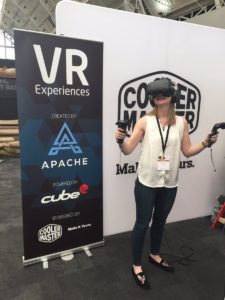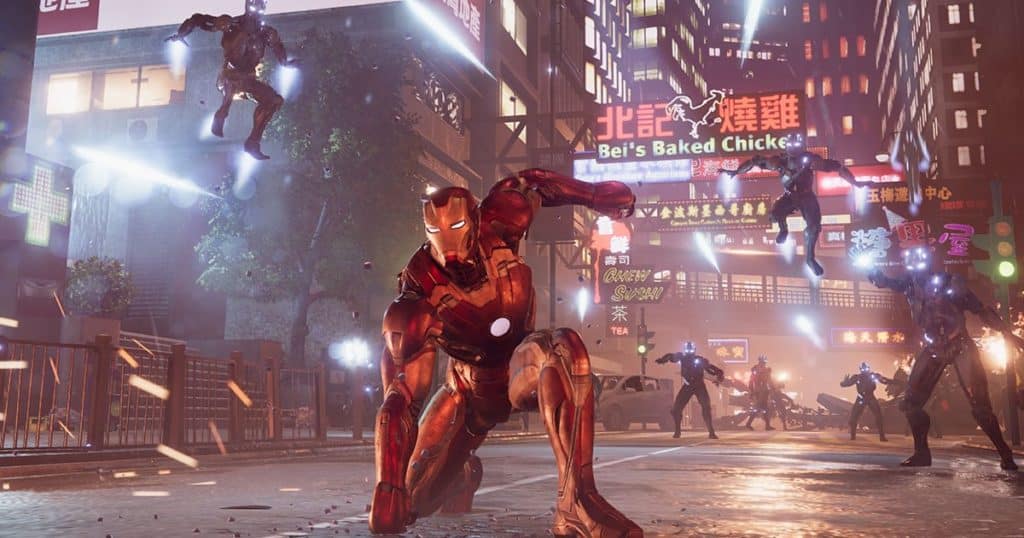This article was written by Decision Magazine for WardWilliams Creative and Creative UK.
After nearly three decades of working on other people’s intellectual property, Adam Vahed wants his own. Because the founder of virtual reality and augmented reality development agency Apache sees launching his own VR game as the route to additional revenue streams.
“The IP has always belonged to the client until this year, but we always had the ambition to to mitigate risk by creating our own to create an on-going revenue stream, albeit a smaller one,” he explains. “We built up some funds last year that enabled us to focus on making our own game.”
Vahed admits it’s somewhat of an experiment from a financial perspective, especially because the VR games market is limited due to the cost and size of the headsets. “But,” he says, “they’re getting lighter and more affordable surprisingly quickly.”
VR Curious

The demand for high-end but affordable VR games from what he calls the “VR curious” will lead to growth in location-based entertainment, says Vahed. To explore the potential of this new market, Apache set up a spin-off company, VRX Networks, which offers users the chance to play games at shopping malls and cinema foyers in Glasgow, Essex and the West Midlands (and in the US and Australia).
The price, a few pounds per play, includes the use of the hardware (headsets, high powered PCs and the playing booths), which VRX Networks owns and supplies. They are exploring different business models to see what works best, for example some venues provide the space and staffing in return for a cut of the income, and in others VRX Networks pays for the space and provides staff.
“Right now it’s still a learning exercise,” says Vahed. “We’re having to spend a lot of money to get the infrastructure in place but a third round of funding it will enable us to grow something exciting that will be big over the next few years as the technology continues to get better.
“Our targets are a subset of the gaming community, one which is notoriously hard to please. If their expectations are not quite met – even if they quite enjoyed the game – they won’t feel it’s value for money and they will absolutely rip it apart in their reviews.
The development of the game has been time and resource consuming for Apache, he adds. “It has taken six months so far to develop; client projects take about three. If it takes off we might be able to invest more time and resources in developing our own games but we will probably limit it to one or two a year.”
The business has been self-funded until now but Vahed says private equity investment would partly be to help with the needed resources for game development. “We had avoided external investment – and didn’t actively seek it – as I never felt it was the right time,” he says. “But when we were approached and talked, I thought there might be some common ground. Timing is important; we have been approached before but never felt it would work. But the world of augmented and virtual reality is exploding and this could be the time for companies in this sector to really make the most of it; go big or not at all.”
Importance of patience
Apache started out in 1991 doing software development, websites and e-commerce but later became one of the earliest adopters of commercial virtual reality and augmented reality. “Twenty-seven years is an awful long time for a technology company; the internet was not even a word most people had even heard of when we began,” says Vahed. “Although early augmented reality was pretty ropey stuff, it was incredibly exciting; we saw it could develop into something quite cool, so we focused on it.”
Vahed has seen a lot of competitors come into the market since then. “We’re ahead of the curve, and creativity is something that the UK excels in as a nation. When we started there were maybe five companies in the world doing what we did but now there are thousands, maybe tens of thousands. That makes it harder to compete on the world stage; though many are offering something fairly average, it can be difficult for the consumer to differentiate.”
So how do Apache differentiate themselves? Vahed’s founding principle for the business was that “any sufficiently advanced technology is indistinguishable from magic, and when you witness magic first-hand, you never forget it.”
“Our aim,” says Vahed, “is to help brands distil their message into cutting-edge creative concoctions that enchant their target customers, with beautiful interactive experiences that beguile and delight, to produce amazing content and experiences that leave people smiling and make people happy.”

Passion is crucial
Vahed muses: “I know passion is an overused word, but having a true passion for your craft is key. It sounds obvious but that’s what makes you go above and beyond the brief, to always try to push the boundaries to exceed expectations.”
What’s crucial is making the user experience intuitive, he says. “People have only a few minutes to first engage with a game. So we really think about how they will engage and whether they will enjoy and understand it.”
Much of the agency’s work is with film studio clients such as Warner Brothers and Disney. Through VR, the game user can ‘become’ characters like the Iron Man or Batman or Superman.
Being “a bunch of film geeks” is an advantage with this work, Vahed says, “and it means we get a fairly loose brief with a lot of latitude in terms of the characters we work with. For example we were able to get away with making Iron Man dance, but certain of the characters can’t do certain things because fans of their films are very hot on the detail; they know if the character’s clothes or the colour of a beam of light is wrong.”
One of the issues related to film industry work is having to work on short deadlines. Vahed explains: “Movies are planned a long time ahead so you would think there would be plenty of time, but after all the stakeholders have been consulted and we get involved, it can come right down to the wire.”
R& D Tax Relief
As the business has grown, Vahed has tried to back away from hands-on programming. “I realise that coding is not a valuable use of my time so I have positioned myself to work on instead of in the company.” One area he finds challenging is pursuing opportunities for tax relief. “We did get some R&D tax credit some time ago but I’m not sure we qualify now – it can be difficult for a creative company to know how much of what it does can be construed as R&D. And we’ve not really taken advantage of video-game tax relief; it’s just more paperwork.”
What would help he says, would be if the government reduced corporation tax for creative SMEs, even if it was done in a way that meant it all has to be reinvested. “There is nothing more galling than doing well and having to give a chunk of it to the government, when companies like Google are ducking out of millions.”
The eleven-strong team at Apache includes traditional 3D and animation artists as well as software developers. “Creativity takes different forms and we need to have a good combination of skill sets,” he says. “Artwork is the most obvious expression but programming is just as creative as something that is more traditionally artistic.”
Benefits of a Collaborative Environment

Apache tries to encourage a collaborative environment where new ideas are welcome, no matter how “crazy” they seem. “We get together and brainstorm a few ideas and usually come to a consensus. We don’t have a traditional hierarchy, mainly because nobody would listen to me,” Vahed laughs.
The education system is often criticised by tech-based businesses for not producing the right skill sets but Vahed says things are improving. “Using the technology is second nature to young people but what’s important in programming is more about the workings out, the process – not how to achieve it; like being able to use a calculator without knowing what the actual calculation is. In the past schools have focused on the result, but not how to achieve it. But teaching is beginning to evolve and there is more of a focus on fostering an environment of being curious and creative problem-solving”
Even so, he observes, there’s a lack of good training in programming in universities. “Everybody we have employed with degrees in computer science and programming we have had to re-train.”
Outsourcing isn’t the solution, he adds, “because it would lead to a disconnected office. The potential for disaster is enormous; we need people in the same place because face-to-face discussions are key.”
Technology progresses at a rapid rate of knots, he explains, and a creative company has to maintain its connection with the customer. “We need to pace ourselves so we don’t move ahead of what people are comfortable with. You can focus too much on the technology while there are other issues. For example, the VR and AR sector didn’t realise that people had no desire to look like geeks with those giant headsets.”
Virtual Vs Reality

A further issue is the perennial question around whether people confuse the virtual world with reality; whether they are influenced by violent computer games, for example. With ever more realistic visuals will this become a bigger issue?
Vahed ponders the question: “In VR and AR, things have to work physically as they would in the real world; it has to be believable, realistic. You can’t physically touch anything but the fact that you can see your hands is enough to immerse you.
“Virtual reality is so immersive, it’s surprising how much of an effect it can have; there is an extraordinary statistic that people have four times higher recall when they are viewing something in VR than in real life. When you get sound and vision and a sense of touch or smell, it’s very visceral; there is a synasthesia, a fusion of the senses – and biometric reactions are higher too.”
However, he adds: “Although we are trying to make people think something is real, I do get concerned that my boys spend too much time in front of the screen, shooting stuff. But actually kids can distinguish between what really is real and what’s not, between what’s right and wrong.”








